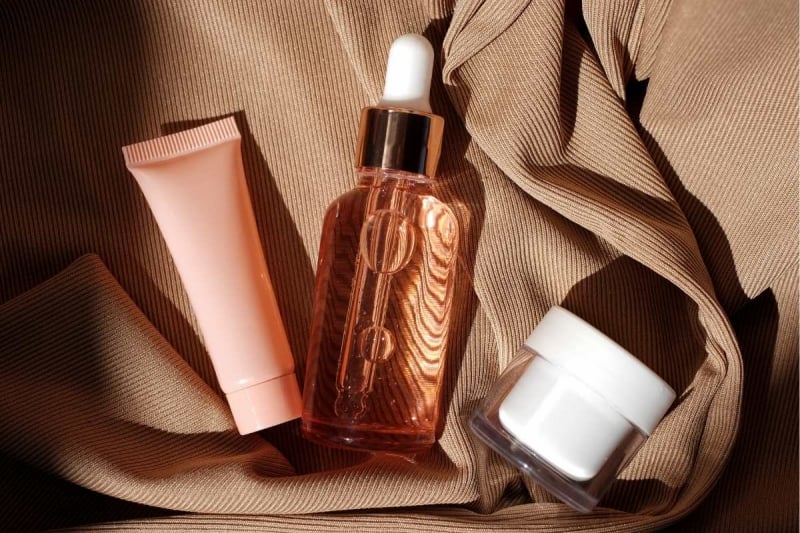Not all skincare routines work everywhere. This climate-proof skincare routine helps you adapt across climates that change as quickly as your travel plans. You might feel your skin tighten the moment you land in a dry country, or notice breakouts after stepping into a humid city. Climate shapes how your skin behaves, what it needs, and how well your products perform.
Rather than chasing perfection, this guide is about responding to your surroundings with care and intention. Whether you’re bracing against icy winds or trying to stop your skin from melting in the heat, here’s how to adjust your routine for the weather you’re in.
Also read: Sensitive Skincare While Travelling: Essential Tips and Product Guide
Hot and Sunny Climates

Image Credit: Maridav via Canva Pro
What your skin needs
If you’re traveling to a summer destination, building a climate-proof skincare routine around breathability and sun protection will help your skin stay clear and comfortable. You may notice surface oiliness, but underneath, the skin can still be dry. The goal here is to keep your routine light, breathable, and protective. Think of your skincare like summer clothing: the more breathable, the better.
Instead of piling on products, focus on items that do double duty. For example, a hydrating antioxidant serum can both treat and protect. Similarly, a gel-based moisturiser offers hydration without heaviness. And of course, daily sunscreen is essential.
Key strategies
This climate calls for a cooling and minimal routine. Choose products that absorb quickly and help prevent overheating.
-
Use a gel or foam cleanser to clear sweat and sunscreen buildup
-
Include a vitamin C serum to defend against UV damage
-
Swap heavy creams for water-based moisturisers that hydrate without clogging
-
Apply a high-SPF sunscreen that stays put, even in sweat
-
Optional: Use a facial mist to cool down throughout the day
Suggested products
-
Cleanser: La Roche-Posay Effaclar Purifying Gel – clears oil without drying
-
Serum: The Inkey List Vitamin C Serum – lightweight antioxidant boost
-
Moisturiser: Clinique Moisture Surge – hydrating and oil-free
-
Sunscreen: Biore UV Aqua Rich Watery Essence SPF 50+ – stays light on the skin
Also read: 18 Must-Try Singapore Beauty Brands From Skincare to Makeup
Cold and Dry Climates

Image Credit: Chelsea Hansen via Canva Pro
What your skin needs
If you’re travelling to places like Seoul in winter, Switzerland in January, or New Zealand during the colder months, you’re likely to face a mix of icy winds, indoor heating, and very low humidity. These conditions can be especially harsh on your skin, stripping away natural oils and leaving it feeling tight, flaky, or red.
So, a climate-proof skincare routine for cold and dry environments should focus on restoring lost moisture and reinforcing your skin barrier.
To cope, build your routine in layers. Start with gentle hydration, then seal it in with something richer. Just like layering clothes in winter, your skin benefits from both lightweight humectants and thick occlusives. This way, moisture stays in, and harsh air stays out.
Key strategies
This is a climate where moisture loss is constant. Each product should help hold hydration and reinforce the skin barrier.
-
Start with a cream or balm cleanser to avoid stripping oils
-
Layer a hydrating toner or essence to attract water into the skin
-
Use a barrier serum with ceramides or panthenol to support recovery
-
Apply a rich moisturiser that locks in hydration and protects against wind
-
Add a balm or oil layer before sleep or going outside for extra protection
-
Use sunscreen daily, especially in snowy places where UV rays reflect strongly
Suggested products
-
Cleanser: The Inkey List Oat Cleansing Balm – gentle and soothing
-
Hydrating layer: Hada Labo Gokujyun Premium Lotion – deeply hydrating
-
Serum: Dr. Jart+ Ceramidin Serum – helps repair and strengthen the skin barrier
-
Moisturiser: First Aid Beauty Ultra Repair Cream – rich in emollients
-
Balm or oil: Aquaphor Healing Ointment or Biossance Squalane + Rose Oil – seals in moisture
-
Sunscreen: EltaMD UV Daily SPF 40 – moisturising with broad-spectrum protection
Also read: 13 Travel Packing Hacks Every Traveller Should Know
Humid and Tropical Climates

Image Credit: Oneinchpunch via Canva Pro
What your skin needs
If you’re heading to places with tropical climates like Bangkok or Ho Chi Minh City, expect high humidity, intense sun, and a whole lot of sweat. In hot and humid places, your skin can feel sticky, congested, and oily. However, it may still be dehydrated underneath. Excess sweat and pollution make it harder for your skin to stay clear. Therefore, a climate-proof skincare routine for tropical climates hould help your skin stay clear, cool, and breathable.
Heavy products are not just unnecessary, they can make things worse. Instead, focus on light hydration, occasional exfoliation, and sunscreen that stays in place. It’s also helpful to simplify your steps. In high humidity, fewer products can often lead to better results.
Key strategies
The main aim here is to support your skin without overwhelming it. Balance is key.
-
Use a gentle foaming cleanser to remove sweat, dirt, and SPF
-
Introduce a mild exfoliating toner to help clear clogged pores
-
Skip thick serums and use watery essences for lightweight hydration
-
Use an oil-free moisturiser, or skip it if your skin already feels comfortable
-
Choose a sunscreen that is sweat-proof and non-comedogenic
Suggested products
-
Cleanser: KraveBeauty Matcha Hemp Hydrating Cleanser – fresh and non-drying
-
Toner: COSRX AHA/BHA Clarifying Treatment Toner – gentle exfoliation
-
Serum: The Ordinary Niacinamide 10% + Zinc – helps regulate oil and reduce blemishes
-
Moisturiser: Neutrogena Hydro Boost Water Gel – light and hydrating
-
Sunscreen: Anessa Perfect UV Skincare Milk SPF 50+ – high protection without heaviness
Also read: Travel Beauty Hacks: 5 Skincare Tips for Your Next Long-Haul Flight
Dry and Arid Climates

Image Credit: RossHelen via Canva Pro
What your skin needs
In deserts, mountain regions, or on long-haul flights, you will often find the air extremely dry. There’s little to no moisture for your skin to absorb. As a result, you may experience flakiness, tightness, and dullness. To prevent dullness and tightness, a climate-proof skincare routine for dry air needs to focus on hydration and protection.
The solution is to layer smart. Use humectants to pull in moisture, then follow with emollients and occlusives to lock it in. This helps your skin feel soft, look brighter, and stay balanced even when the air around you is doing the opposite.
Key strategies
This climate calls for hydration from the inside out. Every layer should work to add or trap water.
-
Use a gentle, hydrating cleanser that does not strip your skin
-
Apply a mist or toner during the day to replenish water loss
-
Choose a hyaluronic acid serum to attract and hold hydration
-
Layer on a thick moisturiser to smooth and protect
-
Add a balm or oil as your final layer, especially at night
-
Use sunscreen, as dry air still allows UV damage to occur
Suggested products
-
Cleanser: CeraVe Hydrating Facial Cleanser – soft and barrier-safe
-
Toner: Pyunkang Yul Mist Toner – refreshing and simple
-
Serum: The Ordinary Hyaluronic Acid 2% + B5 – multi-depth hydration
-
Moisturiser: Bioderma Atoderm Intensive Baume – nourishing and long-lasting
-
Balm or oil: Kiehl’s Midnight Recovery Concentrate or Vaseline – helps prevent overnight moisture loss
Also read: Where to Shop for Skincare at Changi Airport: Duty-Free & Jewel Guide
Final thoughts

Image Credit: Danah Pascua via Canva Pro
A climate-proof skincare routine does not need to be complicated. Often, a few thoughtful swaps are all it takes. Your skin responds to the environment just as much as it does to your products. Whether the weather is hot, cold, humid, or dry, each climate presents its own set of challenges.
Rather than replacing your whole routine, focus on adjusting it with care. Pay attention to what your skin needs, and make small changes that respond to your surroundings.
Caring for your skin while travelling is not about getting it perfect. It is about knowing what helps, what harms, and choosing what works for where you are.




